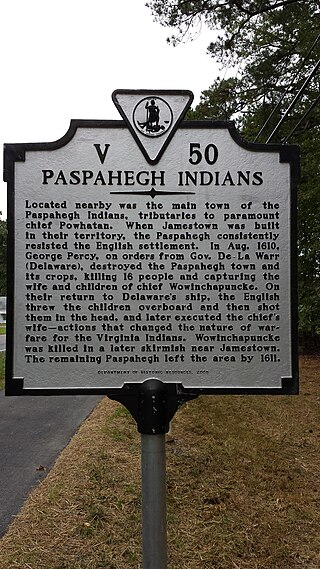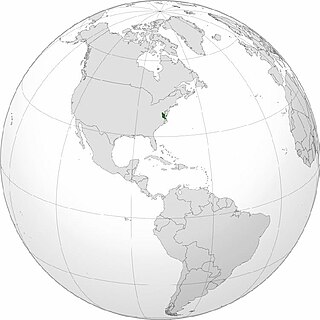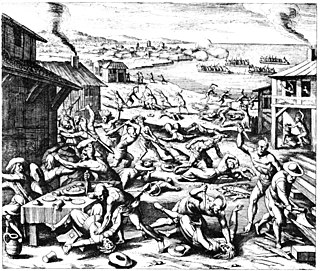Related Research Articles

The Colony of Virginia, chartered in 1606 and settled in 1607, was the first enduring English colony in North America, following failed attempts at settlement on Newfoundland by Sir Humphrey Gilbert in 1583 and the Roanoke Colony by Sir Walter Raleigh in the late 1580s.

The Powhatan people may refer to any of the Indigenous Algonquian people that are traditionally from eastern Virginia. All of the Powhatan groups descend from the Powhatan Confederacy. In some instances, The Powhatan may refer to one of the leaders of the people. This is most commonly the case in historical records from English colonial accounts. The Powhatans have also been known as Virginia Algonquians, as the Powhatan language is an eastern-Algonquian language, also known as Virginia Algonquian. It is estimated that there were about 14,000–21,000 Powhatan people in eastern Virginia, when English colonists established Jamestown in 1607.

Opechancanough was paramount chief of the Powhatan Confederacy in present-day Virginia from 1618 until his death. He had been a leader in the confederacy formed by his older brother Powhatan, from whom he inherited the paramountcy.

Powhatan, whose proper name was Wahunsenacawh, was the leader of the Powhatan, an alliance of Algonquian-speaking Native Americans living in Tsenacommacah, in the Tidewater region of Virginia at the time when English settlers landed at Jamestown in 1607.

The Paspahegh tribe was a Native American tributary to the Powhatan paramount chiefdom, incorporated into the chiefdom around 1596 or 1597. The Paspahegh Indian tribe lived in present-day Charles City and James City counties, Virginia. The Powhatan Confederacy included Indigenous peoples of the Northeastern Woodlands who spoke a related Eastern Algonquian languages.
Weroance is an Algonquian word meaning leader or commander among the Powhatan confederacy of the Virginia coast and Chesapeake Bay region. Weroances were under a paramount chief called Powhatan. The Powhatan Confederacy, encountered by the colonists of Jamestown and adjacent area of the Virginia Colony beginning in 1607, spoke an Algonquian language. Each tribe of the Powhatan Confederacy was led by its own weroance. Most foreign writers who have come across a weroance only did so on a special occasion. This is the case because a foreigner's presence was special. John Smith noted that there are few differences between weroances and their subjects.

Werowocomoco was a village that served as the headquarters of Chief Powhatan, a Virginia Algonquian political and spiritual leader when the English founded Jamestown in 1607. The name Werowocomoco comes from the Powhatan werowans (weroance), meaning "leader" in English; and komakah (-comoco), "settlement". The town was documented by English settlers in 1608 as located near the north bank of the York River in what is now Gloucester County. It was separated by that river and the narrow Virginia Peninsula from the English settlement of Jamestown, located on the James River.

The Native American tribes in Virginia are the indigenous tribes who currently live or have historically lived in what is now the Commonwealth of Virginia in the United States of America.

The Rappahannock are a federally recognized tribe in Virginia and one of the eleven state-recognized tribes. They are made up of descendants of several small Algonquian-speaking tribes who merged in the late 17th century. In January 2018, they were one of six Virginia tribes to gain federal recognition by passage of the Thomasina E. Jordan Indian Tribes of Virginia Federal Recognition Act of 2017.

Tsenacommacah is the name given by the Powhatan people to their native homeland, the area encompassing all of Tidewater Virginia and parts of the Eastern Shore. More precisely, its boundaries spanned 100 miles (160 km) by 100 miles (160 km) from near the south side of the mouth of the James River all the way north to the south end of the Potomac River and from the Eastern Shore west to about the Fall Line of the rivers.

The Anglo–Powhatan Wars were three wars fought between settlers of the Virginia Colony and Algonquin Indians of the Powhatan Confederacy in the early 17th century. The first war started in 1609 and ended in a peace settlement in 1614. The second war lasted from 1622 to 1632. The third war lasted from 1644 until 1646 and ended when Opechancanough was captured and killed. That war resulted in a defined boundary between the Indians and colonial lands that could only be crossed for official business with a special pass. This situation lasted until 1677 and the Treaty of Middle Plantation which established Indian reservations following Bacon's Rebellion.
Totopotomoi was a Native American leader from what is now Virginia. He served as the chief of Pamunkey and as werowance of the Powhatan Paramount Chiefdom for the term lasting from about 1649-1656, when he died in the Battle of Bloody Run.
Necotowance was Werowance (chief) of the Pamunkey tribe and Paramount Chief of the Powhatan Confederacy after Opechancanough, from 1646 until his death sometime before 1655. Necotowance signed a treaty with the Colony of Virginia in 1646, at which time he was addressed by the English as "King of the Indians."
Kiskiack was a Native American tribal group of the Powhatan Confederacy in what is present-day York County, Virginia. The name means "Wide Land" or "Bread Place" in the native language, one of the Virginia Algonquian languages. It was also the name of their village on the Virginia Peninsula.

Bermuda Hundred was the first administrative division in the English colony of Virginia. It was founded by Sir Thomas Dale in 1613, six years after Jamestown. At the southwestern edge of the confluence of the Appomattox and James Rivers opposite City Point, annexed to Hopewell, Virginia in 1923, Bermuda Hundred was a port town for many years. The terminology "Bermuda Hundred" also included a large area adjacent to the town. In the colonial era, "hundreds" were large developments of many acres, arising from the English term to define an area which would support 100 homesteads. The port at the town of Bermuda Hundred was intended to serve other "hundreds" in addition to Bermuda Hundred.
Fort Henry was an English frontier fort in 17th century colonial Virginia near the falls of the Appomattox River. Its exact location has been debated, but the most popular one is on a bluff about four blocks north of the corner of W. Washington and N. South Streets in Petersburg.

Jamestown, also Jamestowne, was the first settlement of the Virginia Colony, founded in 1607, and served as the capital of Virginia until 1699, when the seat of government was moved to Williamsburg. This article covers the history of the fort and town at Jamestown proper, as well as colony-wide trends resulting from and affecting the town during the time period in which it was the colonial capital of Virginia.
The Wicocomico, Wiccocomoco, Wighcocomoco, or Wicomico were an Algonquian-speaking tribe who lived in Northumberland County, Virginia, at the head and slightly north of the Little Wicomico River. They were the first native people on the mainland encountered by Captain John Smith, prior to his famous interaction with Pamunkee and Pocahontas of the Powhatan people. Due to constant encroachment and manipulation by settlers, opportunists and Captain Smith, as well as internal conflict regarding how to respond to these, the tribe splintered. The colonial court of Virginia ordered them to merge with a smaller tribe and renamed the Wicocomico. They were assigned a flag -- and a reservation of 4,400 acres (18 km2) near Dividing Creek, south of the Great Wicomico River.

Opossunoquonuske, was a Weroansqua of an Appomattoc town near the mouth of the Appomattox River. Weroansqua is an Algonquian word meaning leader or commander among the Powhatan confederacy of Virginia coast and Chesapeake Bay region. She was known as the queen of Appamatuck, The community she led was large enough to provide an estimated twenty warriors to the Powhatan Confederacy.
Peracuta was a 17th-century leader of the Appomattoc tribe in what is now the U.S. state of Virginia. During his reign, he worked with the English colony of Virginia in an attempt to recapture the former power of past paramount chiefs and maintain peaceful unity among the tribe under his leadership.
References
- Chapter 4, A Study of Virginia Indians and Jamestown: The First Century, National Park Service
- Richard L. Jones, Dinwiddie County: Carrefour of the Commonwealth